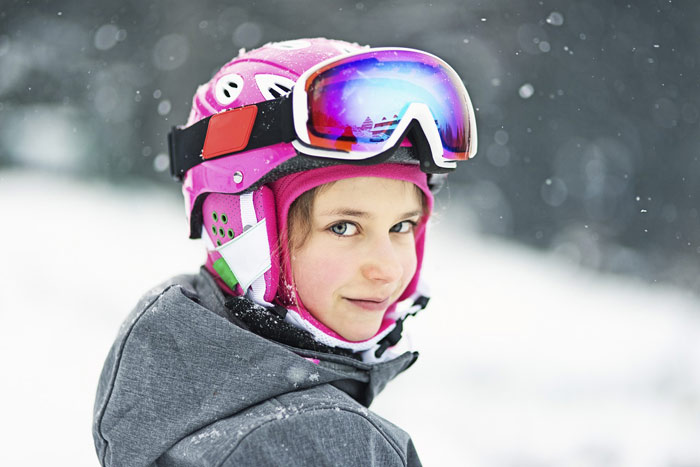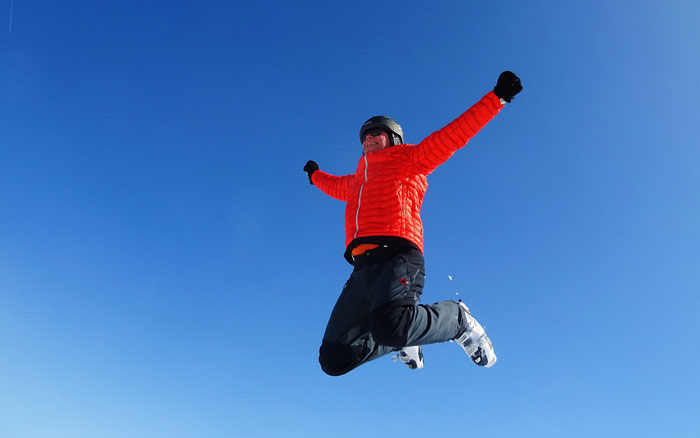When & How to Start Kids Skiing?
The best way parents can teach their children to ski is to come to any decent ski resort, pay a lot of money, send the kids to a ski school, and keep as far away from that school as possible. If you do not have such an opportunity, keep reading this article.

The greatest danger
The greatest danger of skiing with kids is that parents can have a heart attack worrying about them: The child will not be able to stop! This dummy is going to run into him! The kid is sure to fly into a ravine! If the parents’ nervous system is strong enough, and they do not want to enjoy normal winter activities (sledding, snowball fights, making a snowman), they can go that extra mile and start to teach their children to ski.
The best age to start
As a rule, age does not matter. Sometimes parents with 6-month and one-year-old toddlers in backpacks can be seen on the slopes (what an absolutely dangerous nonsense!). Sometimes you can see two and three-year-old kids skiing.
However, you should begin when the child is at least 4 years. Before this age, children are not physically ready to ski. To achieve some result at the age of 3 years, you need 12 hours of time, two liters of tears, and a million nerve cells. At four, the same result can be achieved in a half hour. Is the game worth the candle? If your goal is to boast before friends that your kid has been skiing for a long time since the age of three, you are welcome! But if you want to make the process relatively painless for the child and turn skiing into fun, wait till the age of 4 years. Regardless of whether you start at 3, 4, 5 or 6 years, the kids will be skiing at about the same level by the age of 8 or 9.
Snowboarding requires more coordination than skiing. As a rule, children are not ready for snowboarding till the age of 7 or 8 years.
Ski gear and equipment
The best ski options are glittering pink skis for girls and blue skis with a racing car print for boys. Alternatively, you can simply decorate the skis with stickers – they will be easier to distinguish, and the children will be happy. It is not necessary for children to have the latest model of skis and the most expensive ski boots, so you may simply take them for rent.
The most important part is the boots: if they are uncomfortable, the child will whine and get capricious. Do not forget to ask a specialist to adjust the ski binding in accordance with the child’s height and weight. Ski poles are not needed up to the age of 8-9 years: younger kids cannot coordinate their arms and legs movements at the same time, so the poles will only interfere with their performance.
Do not dress your kids too warm. It is better to put on “multi-layered” clothes to be able to take something off and put it in the backpack. Do not forget to bring something to eat. Mittens, a hat (a balaclava worn under the helmet) and socks are all a must, and they must be made of modern synthetic materials – wool and cotton get wet, do not keep their shape well and irritate the skin. Special ski goggles will protect your eyes from the sun and in case of falling. Some important rules for children are as follows: if you do not wear a helmet, you will not go skiing or snowboarding; if you do not apply a sunscreen on your face, you will not go out.
On the mountain
It is best to start skiing on a flat surface or on a small slope so that the child would not have to slow down to stop. It is important to do everything slowly and without rush. You need to make a pause at the first signs of fear, fatigue or lack of enthusiasm. The aim of the first lesson should be to achieve speed control. Call the classic “snow plough” a different name – “a slice of pizza” or “a triangle”, but the child should learn to keep the toes pointing inwards and heels apart. Until the kid masters this technique, you cannot take him/her on the slope. Tell the child that the most important thing in downhill skiing is to be able to stop at any time.
Before going to the ski lift, give your child some time to consider it properly. If possible, ask to run the lift at a slower speed. Leave your ski poles or take just one. If the child is afraid to ski down the hill, it is useless to convince him/her. Seek for a compromise and ask the kid to ski from the middle of the hill. To get to the middle of the mountain, you should move as follows: place the child between your skis and hold the ski pole horizontally in front of the child to let him/her get hold of it. Stay in the snow plough position and start to move downhill. Of course, skiing like this is not recommended, if you lack experience.
Duration of ski lessons

Experience shows that children are not subject to fatigue. However, they are fond of tricks. For example, they can ski for three hours and say they cannot carry their skis. They can walk 200 meters to the nearest cafe, where cocoa is sold, but they cannot walk a hundred meters to the bus stop to go home. They can ski between the sticks stuck in the snow, but they cannot collect them. They can ski with their parents for one and a half hours, but with a couple of friends they will stay out for two hundred forty-five and a half hours! Any parent can give a lot of similar examples.
If you want the kids to ski longer, think about how to entertain them. A great idea to keep the children interested is a balloon. Tie it to your rucksack and say that “you are skiing with a balloon” (it is important to warn the child that the balloon can burst, but you have more balloons at home). Get to know other children skiing around and let them ski together. Make an arch from a twig and ask your child to ski under it.
If a protest has been unleashed, it is best to take a break and have some snacks. Juice, cocoa, and cookies can have a wonderful effect and inspire the children for further feats.
Criticism is useless
It is useless to criticize children. Nothing but praise brings the needed result. Try to notice even the smallest achievements. The child is standing on skis without going anywhere, but does not fall – say some words of praise. Even if the child falls, you can say “well done, you are not crying.” If the child falls down and bursts into tears, say “it is nice that you have fallen just once – when I was learning to ski, I was falling about 25 times a day!”
Important laws of teaching the child to ski
Before you go to ski with children, you need to remember the following laws:
- The child will be dressed either too hot or too cold.
- The child will want to use the toilet at the farthest point from any appropriate place.
- The lift gets broken in the morning, but not at the end of the day.
- Broken is exactly the same lift your child has finally learned to use.
- At first, the child will not want to go skiing, and then he/she will be reluctant to leave the slope.
- The whole event will cost you much more than you expected.
- If the snow is good on the mountain, the weather will be bad. If the weather is good, the snow is bad. If the weather and the snow are good, there will be too many people on the piste.
- You are sure to forget something, so you will have to buy it at the most expensive price somewhere near the mountain. It will also turn out that you already have a few similar items at home.
- The louder parents shout at their children, the worse the kids will ski.
- You will fall exactly at the moment when you are showing your child “how to ski”.
- Once the children learn how to ski well, they will not want to ski with you.
- Your ski gear and outfit will never make you the best. A dirty child with the worst equipment will prove the best one to ski.
